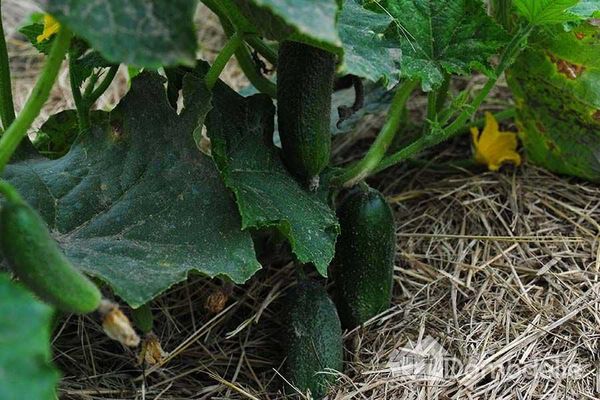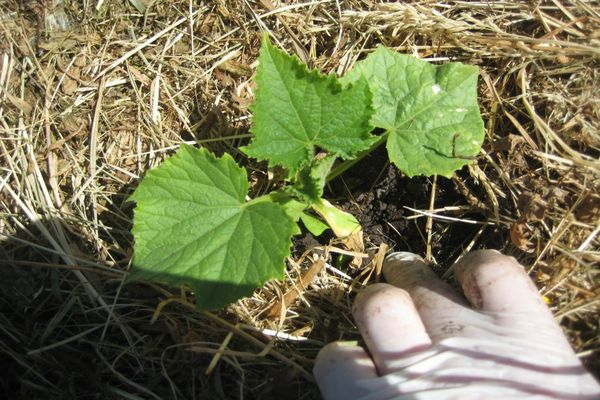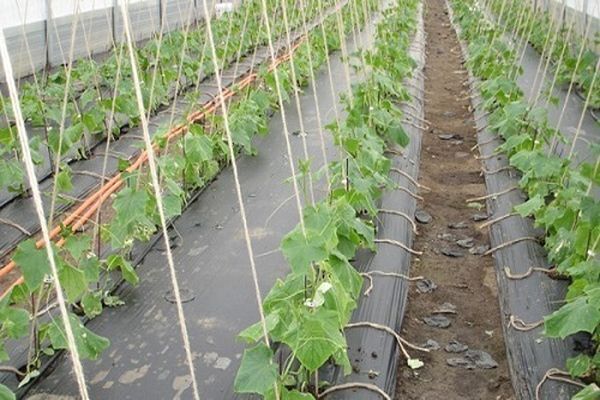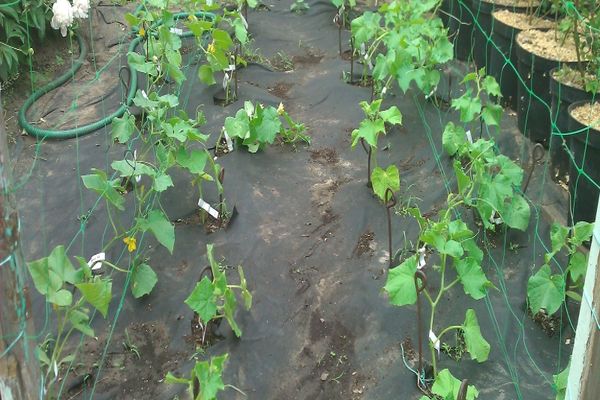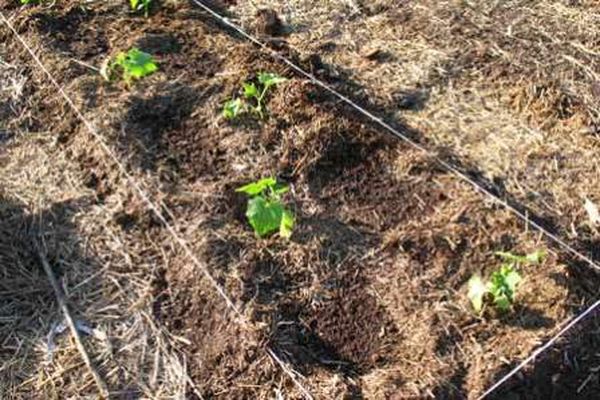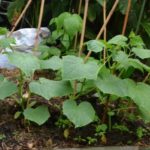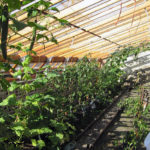An important condition for a rich harvest is constant moisture in the root zone; mulching cucumbers in a greenhouse allows you to maintain it without additional labor costs. Mulch makes caring for moisture-loving crops easier and reduces water consumption. It is beneficial to use it in any growing method (open ground, greenhouse).
The benefits of mulching
It is not difficult to understand the benefits of mulching cucumbers; the long list of advantages that this agricultural technique provides convinces and motivates its use.
Let's look at all the positive aspects:
- Mulched beds suffer less from daily temperature fluctuations at the beginning of summer and at the end of the season. Cucumber roots are protected from low temperatures, which reduces stress from bad weather conditions.
- The mulch layer prevents moisture evaporation. Even with rare visits to the dacha, cucumbers in the open ground (greenhouse) do not lack water. The soil remains moist for a long time, the roots do not suffer from overheating.
- In a greenhouse and on a ridge, the soil under a layer of organic material remains loose. Summer residents do not need to loosen the soil after each watering. A crust does not form on the surface of the earth. Earthworms reproduce well under mulch, loosen the soil, and enrich it with oxygen. Roots develop better in loose, moist soil.
- Soil fertility is better preserved when vegetables are grown annually. Organic material protects it from aggressive influences (washing out, weathering); organic matter, by overheating, increases the humus content and increases the fertile layer.
- Weeds do not grow on beds covered with a layer of mulch. The time for weeding is reduced. Cucumbers (fruits, leaves) do not come into contact with the ground, therefore they are less susceptible to infection by fungi and are less likely to be attacked by pests.
How to mulch cucumbers
You can mulch cucumbers in a greenhouse (open ground) with different materials. Their choice depends on specific conditions: the quality of the soil, the availability of this or that material at the dacha or the possibility of purchasing it.
Mulching material comes in two types:
- organic (natural);
- synthetic, manufactured at an industrial enterprise.
Organic mulch
For cucumbers grown in depleted, poor soil, it is worth using homemade compost, manure (horse, cow) or humus.Manure provides cucumbers with additional nutrition and releases nitrogen in a form accessible to plants. Manure is not used in its pure form; it is mixed with a small amount of hay or straw.
Using grass clippings
Most summer residents have a reasonable question: is it possible to mulch beds with cucumbers with lawn grass, weeds growing in vacant lots or in the garden? Grass is the cheapest option for organic mulch and can be mowed with a trimmer, scythe, or lawn mower. If you follow the rules of use, there will be a good harvest of cucumbers.
The first rule is not to mulch cucumbers with freshly cut grass. It needs to be dried. Fresh grass can rot, it cakes and does not allow air to pass through well. Slugs and other pests crawl onto damp grass. They can carry diseases.
The dried mown grass is laid out in a layer of 7 cm. A thinner layer will not maintain the optimal level of soil moisture. Do not use grass with seeds for mowing.
It is not recommended to use straw that has begun to rot; it will slow down the development of cucumbers; we mulch only with fresh material.
Fresh straw is pre-fertilized, for every 10 kg of raw materials add:
- 200 g urea;
- 200 g superphosphate;
- 120 g potassium salt.
Accelerated preparation of sawdust
Sawdust that is completely rotted or semi-rotted is suitable for use. You cannot cover the soil with fresh sawdust; they will take nitrogen from it. It is recommended to carry out special treatment of fresh sawdust before use.
To speed up the preparation of sawdust, you will need film, water, and urea. Lay the film on the ground, scatter 3-4 buckets of fresh shavings on it. Scatter 200 grams of urea on top, pour water from a watering can over everything.One such layer of water takes up to 10 liters.
Usually two layers are made, both are filled with urea and watered. The formed pile is wrapped in polyethylene and left for 2 weeks. Sawdust prepared in this way can be poured onto a cucumber bed.
Mulching cucumbers in open ground with sawdust helps improve the soil structure. In the fall, the mulch that has not rotted over the summer is dug up, adding all the necessary mineral fertilizers. By the next season, the loose soil is ready for new plantings.
Decorative mulch
For many summer residents, the design of a cucumber garden plays an important role. Decorative wood chips will decorate a high, warm bed and perform all the main functions of mulch. You can buy wood chips of any color on the market and they can be used many times.
When planting cucumbers on low ridges, you can sprinkle wood chips not only on the surface of the soil under the cucumbers, but also mulch the paths with it. Trellis with cucumbers will become a decoration for the garden. To retain moisture in the soil, the thickness of the covering layer must be at least 5 cm; this thickness is sufficient to protect against weeds.
If a summer resident has a woodworking machine, he can start making wood chips, saving on its purchase.
Synthetic mulching materials
Many gardeners mulch greenhouse cucumbers with black perforated film. It is laid before planting seedlings on fully prepared soil. Planting holes are made in advance or by cutting into already laid fabric. This method has a disadvantage - overheating of the soil in the summer heat. To avoid this, additionally use a white covering material and lay it on top of the black one.
When sowing cucumbers into the soil with seeds, many summer residents use transparent plastic film.The film creates a greenhouse effect and retains moisture. When sprouts appear, it is carefully cut, releasing the young plants out. Black film and black non-woven material are used in the seedling method of growing cucumbers.
How to mulch cucumbers
In any work carried out in the garden, it is necessary to follow the rules so as not to harm the plants through your actions. Let's figure out how to carry out mulching in order to get more benefits from this simple agricultural technique.
It is better to mulch the prepared (dug up) bed in the spring, at the end, when the earth has already warmed up, but still retains the remnants of natural moisture. The protective layer will prevent rapid drying out of the soil and its compaction.
Before you start mulching the cucumber ridge, prepare the soil:
- remove remnants of roots, grass, and other debris from the surface of the ridge;
- scatter the required amount of fertilizer and dig up the soil;
- water if there is not enough moisture in the ground.
The thickness of the layer placed on the soil depends on the type of mulching material. You need to sprinkle sawdust and other dense materials in a thin layer of 2 to 5 cm. When covering the soil with straw or other light compounds, the thickness is greater, it can reach up to 7 cm.
Not the entire surface of the cucumber bed is covered. To prevent cucumbers from suffering from rot, the root zone is left open.
It is necessary to avoid contact of the mulch with the cucumber stem. Place synthetic materials before planting seedlings (seeds), plant cucumbers in the slots.
In the summer, the mulch rots, turning into humus, so it is regularly added throughout the season. Unrotted remains should be raked in the fall and sent to compost. If you haven’t had time to remove them in the fall, then they are raked at the beginning of winter so as not to slow down the warming of the soil.
An overview of mulching materials and the basic rules for mulching the soil will help the novice gardener master a simple but effective technique caring for cucumbers in open ground and in greenhouses.

